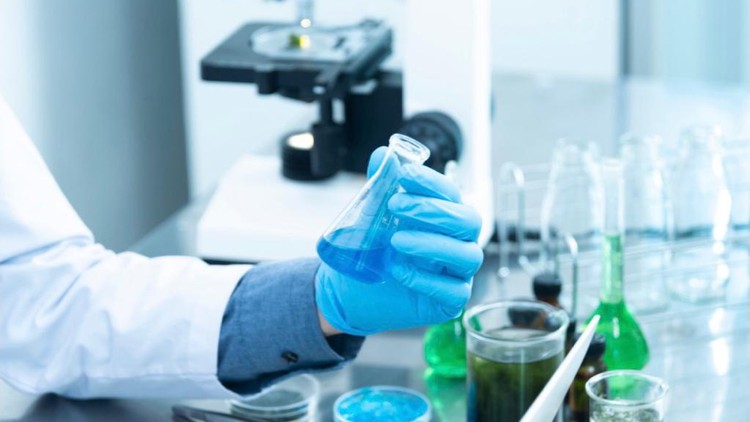Chemistry is fun when you learn from the best tutors. At Go2uni, we present you “The Complete High School and College Chemistry”. We start from the basics and take a deep dive with clear examples and exercises to ensure every concept is understood.
Go2uni presents seasoned tutors with years of experience to offer you The Complete High School and College, the Chemistry course you need to ace your exams.
This course will demystify Chemistry with tonnes of examples, work through exercises and take-home exercises. If you are dreaming of starting a STEM-based career, then this is for you. This course offers you the proper foundation and makes you stand out as a star student in Chemistry.
This course covers all you need to know in Organic Chemistry and Inorganic Chemistry. Starting from a quick introduction to chemistry, Separation Techniques, Stoichiometry, Empirical Formular, Volumetric Analysis, and much more. We use visually descriptive teaching with fun exercises that cover exam questions. This is done to ensure you have clarity on all topics, simplifying Chemistry and ensuring you ace your exams without sleepless nights.
Who this course is for:
Get Instant Notification of New Courses on our
Telegram channel.
· High school students
. College students
.University students who want to brush up
· Anyone with a passion for learning foundational chemistry
Course Introduction
Course overview
Introduction to chemistry
Objectives
Definition of terms
Careers in chemistry
Separation Techniques
Objectives
Filtration, decantation, sieving and distillation
Evaporation, sublimation and precipitation
Crystallization
Stoichiometry
Objectives
Mole ratio and stoichiometry
Mole concept and valency
Balancing of equations
Balancing of equations 2
Reactions 1
Reactions 2
Reactions 3
Mole relationships
Calculations 1
Calculations 2
Calculations 3
Calculations 4
Calculations 5
Mass volume and mole calculation 1
Mass volume and mole calculation 2
Mass volume and mole calculation 3
Limiting reagents 1
Limiting reagents 2
Test questions
Empirical and molecular formulae
Objectives
Definition and calculations
Examples
Percentage composition
Law of chemical combination
Law of definite proportion
Law of multiple proportion
Law of reciprocal proportion
Volumetric analysis
Objectives
Apparatus in volumetric analysis
Definition of terms part 1
Definition of terms part 2
Calculations in Titration
Calculations in Titration and examples part 1
Calculations in Titration and examples part 2
Kinetic theory of matter
Objectives
Definition of terms
Latent heat of fusion and vapourization
Kinetic theory of gases
Periodic table
Objectives
Definition of terms
Group characteristics
Transition metals
Lanthanides and actinides
Periods
Atomic properties and size
Atomic size
Ionic size
Melting and boiling point
Ionization energy
Electron affinity and negativity
Oxygen
Objectives
Definition of terms
Properties and uses of Oxygen
Acidic oxides and preparation
Properties of hydrogen peroxide and its uses
Hydrogen
Objectives
Definition
Methane hydrocarbon
Properties of hydrogen
Practice questions
Chlorine
Objectives
Definition
Hydrogen chloride
Chlorides
Carbon and its compounds
Objectives
Definition of terms
Coal and oxides of carbon
Carbon(iv) and Carbon(II) oxides
Trioxocarbonates(iv)
Water and solutions
Objectives
Definition of terms
Hardness of water
Water Pollution
Solutions
Tyndall effect
Saturated, unsaturated and supersaturated solutions
Solubility and solubility curve
Calculations on solubility 1
Calculations on solubility 2
Calculations on solubility 3
Calculations on solubility 4
Concentration of solution
Acid, bases and salts
Objectives
Definition
Properties of acid
Method of preparation of acids
Uses of acid, Base and Alkalis
Acidic Oxides And Its Preparation.mp4
Ph scale and indicators
Relationship between PH and POH
Relationship between PH and POH 2
Relationship between PH and POH 3
test questions
Calculating pKa and pkb
Salts
Double salt
Classification of salts
Methods of preparing insoluble salts
Electrochemistry
Objectives
Definition of terms
Electrolysis
Mechanism of electrolysis
Preferential discharge of IONS during electrolysis
Position of ions in the electrochemical series
Relative concentration of ions in solution
Nature of the electrodes
Faraday’s laws of electrolysis
Calculations on Faraday’s laws of electrolysis 1
Calculations on Faraday’s laws of electrolysis 2
Calculations on Faraday’s laws of electrolysis 3
Class work
Faraday’s second law
Redox reaction
Oxidation states and balancing of redox reactions
Calculating oxidation numbers
Balancing of redox reactions
Balancing of redox reactions 2
Balancing of redox reactions 3
Balancing of redox reactions 4
Balancing of redox reactions 5
Electrochemical cells
E.M.F of a cell
calculations on E.M.F of a cell
Primary and secondary cells
Rates of chemical reactions
Objectives
Definition of terms
calculating rates of reaction 1
Calculating rates of reaction 2
Measuring rate of reaction from changes in volume and mass
Calculation in Measuring rate of reaction from changes in volume and mass
Collision theory 1
Collision theory 2
Entropy
Calculations in entropy
Gibbs free energy
Features of reaction
Factors affecting rates of reaction 1
Factors affecting rates of reaction 2
Organic chemistry I
Objectives
Definition of terms
Hydrocarbons
Homologous series
Alkanes
Alkyl groups
Alkenes
Alkynes
Alkanols
Alkanoic acids
Alkanoic acids 2
Esters
Esters 2
Test questions
Functional groups
IUPAC nomenclature
IUPAC nomenclature 2
IUPAC nomenclature 3
IUPAC nomenclature 4
IUPAC nomenclature 5
IUPAC nomenclature 6
IUPAC nomenclature 7
IUPAC nomenclature 8
IUPAC nomenclature 9
IUPAC nomenclature 10
IUPAC nomenclature 11
IUPAC nomenclature 12
IUPAC nomenclature 13
Isomerism
Types of Isomers 1
Types of Isomers 2
Functional Isomers
Cycloalkanes
Organic chemistry II
Objectives
Alkanoic acid
Dicarboxylic acids
Ethanoic acid
Chemical properties of ethanoic acid
Esters
Ethyl ethanoate
Fats and oil
Properties of fats and oil
Uses and test for fat and oil
Detergents
Alkanals and alkanones
Distiguishing alkanones from alkanals
Giant molecules
Glucose and frutose
Starch
Properties of starch and cellulose
Proteins
Proteins 2
Properties and test for proteins
Polymers
Polymerization
Condensation Polymerization
Rubber
Industrial chemistry
Objectives
Definition of terms
Pharmaceuticals
Hydrocarbons
Objectives
Definition of terms
Crude oil exploration and processing
Refining
Reforming
Octane and cetane number systems
Acyclic hydrocarbon
Objectives
Alkanes
Methane
Alkenes
Ethene
Ethene 2
Alkynes
Ethynes 1
Ethynes 2
Alkanols
Secondary Alkanols
Tertiary Alkanols 1
Tertiary Alkanols 2
Ethanol
Ethanol 2
